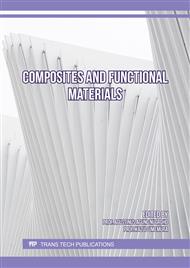[1]
B. Li, X. Cao, H.G. Ong, J.W. Cheah, X. Zhou, Z. Yin, H. Li, J. Wang, F. Boey, W. Huang, H. Zhang, All-Carbon Electronic Devices Fabricated by Directly Grown Single-Walled Carbon Nanotubes on Reduced Graphene Oxide Electrodes, Adv. Mater. 22 (2010) 3058–3061.
DOI: 10.1002/adma.201000736
Google Scholar
[2]
A.G. Olabi, M.A. Abdelkareem, T. Wilberforce, E.T. Sayed, Application of graphene in energy storage device – A review, Renew. Sustain. Energy Rev. 135 (2021) 110026.
DOI: 10.1016/j.rser.2020.110026
Google Scholar
[3]
T. Gabryś, C. Ślusarczyk, Effect of graphene oxide additive on the structure of composite cellulose fibers, Polimery. 65 (2020) 646–650.
DOI: 10.14314/polimery.2020.9.7
Google Scholar
[4]
S. Stankovich, D.A. Dikin, G.H.B. Dommett, K.M. Kohlhaas, E.J. Zimney, E.A. Stach, R.D. Piner, S.T. Nguyen, R.S. Ruoff, Graphene-based composite materials, Nature. 442(2006)282-286.
DOI: 10.1038/nature04969
Google Scholar
[5]
T. Wang, D. Huang, Z. Yang, S. Xu, G. He, X. Li, N. Hu, G. Yin, D. He, L. Zhang, A Review on Graphene-Based Gas/Vapor Sensors with Unique Properties and Potential Applications, Nano-Micro Lett. 8 (2016) 95–119.
DOI: 10.1007/s40820-015-0073-1
Google Scholar
[6]
K. Lee, Y.K. Yoo, M.-S. Chae, K.S. Hwang, J. Lee, H. Kim, D. Hur, J.H. Lee, Highly selective reduced graphene oxide (rGO) sensor based on a peptide aptamer receptor for detecting explosives, Sci. Rep. 9 (2019) 10297.
DOI: 10.1038/s41598-019-45936-z
Google Scholar
[7]
M. Hajimazdarani, N. Naderi, B. Yarmand, A. Kolahi, P. Sangpour, Enhanced optical properties of ZnS–rGO nanocomposites for ultraviolet detection applications, Ceram. Int. 44 (2018) 17878–17884.
DOI: 10.1016/j.ceramint.2018.06.260
Google Scholar
[8]
C.N.R. Rao, A.K. Sood, K.S. Subrahmanyam, A. Govindaraj, Graphene: The New Two-Dimensional Nanomaterial, Angew. Chem. Int. Ed. 48 (2009) 7752–7777.
DOI: 10.1002/anie.200901678
Google Scholar
[9]
D. Li, M.B. Müller, S. Gilje, R.B. Kaner, G.G. Wallace, Processable aqueous dispersions of graphene nanosheets, Nat. Nanotechnol. 3 (2008) 101–105.
DOI: 10.1038/nnano.2007.451
Google Scholar
[10]
E. Jaafar, M. Kashif, S.K. Sahari, Z. Ngaini, Effects of reduction temperatures on morphological, optical, and electrical properties of reduced graphene oxide (rGO) thin films, Mater. Today Proc. 16 (2019) 1702–1707.
DOI: 10.1016/j.matpr.2019.06.039
Google Scholar
[11]
Y. Zeng, T. Li, Y. Yao, T. Li, L. Hu, A. Marconnet, Thermally Conductive Reduced Graphene Oxide Thin Films for Extreme Temperature Sensors, Adv. Funct. Mater. 29 (2019) 1901388.
DOI: 10.1002/adfm.201901388
Google Scholar
[12]
S.-Y. Kim, H.-E. Gang, G.-T. Park, H.-B. Jeon, Y.G. Jeong, Microstructure and electrothermal characterization of transparent reduced graphene oxide thin films manufactured by spin-coating and thermal reduction, Results Phys. 24 (2021) 104107..
DOI: 10.1016/j.rinp.2021.104107
Google Scholar
[13]
M. Fang, X. Xiong, Y. Hao, T. Zhang, H. Wang, H.-M. Cheng, Y. Zeng, Preparation of highly conductive graphene-coated glass fibers by sol-gel and dip-coating method, J. Mater. Sci. Technol. 35 (2019) 1989–1995.
DOI: 10.1016/j.jmst.2019.05.027
Google Scholar
[14]
S.-J. Chang, M.S. Hyun, S. Myung, M.-A. Kang, J.H. Yoo, K.G. Lee, B.G. Choi, Y. Cho, G. Lee, T.J. Park, Graphene growth from reduced graphene oxide by chemical vapour deposition: seeded growth accompanied by restoration, Sci. Rep. 6 (2016) 22653.
DOI: 10.1038/srep22653
Google Scholar
[15]
R.D. Noce, S. Eugénio, K.I. Siwek, T.M. Silva, M.J. Carmezim, A.M.P. Sakita, R.L. Lavall, M.F. Montemor, Direct electrodeposition of hydrogenated reduced graphene oxide from unsonicated solution and its electrochemical response, Diam. Relat. Mater. 104 (2020) 107740.
DOI: 10.1016/j.diamond.2020.107740
Google Scholar
[16]
D.C. Maddumage, S.A. Panamaldeniya, K.M.M.D.K. Kimbulapitiya, D.N.P.R. Jayakantha, M.A.H.M. Munasinghe, B.M.K. Pemasiri, N. Gunawardhana, B.S. Dassanayake, Effect of annealing temperature on electrical properties of RGO thin films deposited by Atomized Spray Pyrolysis, Diam. Relat. Mater. 120 (2021) 108712.
DOI: 10.1016/j.diamond.2021.108712
Google Scholar
[17]
J. Wang, L. Fan, X. Wang, T. Xiao, L. Peng, X. Wang, J. Yu, L. Cao, Z. Xiong, Y. Fu, C. Wang, Q. Shen, W. Wu, Pulsed laser deposition of monolayer and bilayer graphene, Appl. Surf. Sci. 494 (2019) 651–658.
DOI: 10.1016/j.apsusc.2019.07.176
Google Scholar
[18]
D. Ristiani, R. Asih, F. Astuti, M.A. Baqiya, C. Kaewhan, S. Tunmee, H. Nakajima, S. Soontaranon, Darminto, Mesostructural study on graphenic-based carbon prepared from coconut shells by heat treatment and liquid exfoliation, Heliyon. 8 (2022) e09032.
DOI: 10.1016/j.heliyon.2022.e09032
Google Scholar
[19]
A. Anwar, T.-P. Chang, C.-T. Chen, Graphene oxide synthesis using a top–down approach and discrete characterization techniques: a holistic review, Carbon Lett. 32 (2022) 1–38.
DOI: 10.1007/s42823-021-00272-z
Google Scholar
[20]
M.A. Baqiya, A.Y. Nugraheni, W. Islamiyah, A.F. Kurniawan, M.M. Ramli, S. Yamaguchi, Y. Furukawa, S. Soontaranon, E.G.R. Putra, Y. Cahyono, Risdiana, Darminto, Structural study on graphene-based particles prepared from old coconut shell by acid–assisted mechanical exfoliation, Adv. Powder Technol. 31 (2020) 2072–2078.
DOI: 10.1016/j.apt.2020.02.039
Google Scholar
[21]
B. Gupta, N. Kumar, K. Panda, V. Kanan, S. Joshi, I. Visoly-Fisher, Role of oxygen functional groups in reduced graphene oxide for lubrication, Sci. Rep. 7 (2017) 45030..
DOI: 10.1038/srep45030
Google Scholar
[22]
H.S. Maharana, P.K. Rai, A. Basu, Surface-mechanical and electrical properties of pulse electrodeposited Cu–graphene oxide composite coating for electrical contacts, J. Mater. Sci. 52 (2017) 1089–1105.
DOI: 10.1007/s10853-016-0405-7
Google Scholar
[23]
S.K. Mishra, S.N. Tripathi, V. Choudhary, B.D. Gupta, SPR based fibre optic ammonia gas sensor utilizing nanocomposite film of PMMA/reduced graphene oxide prepared by in situ polymerization, Sens. Actuators B Chem. 199 (2014) 190–200.
DOI: 10.1016/j.snb.2014.03.109
Google Scholar
[24]
S. Pei, H.-M. Cheng, The reduction of graphene oxide, Carbon. 50 (2012) 3210–3228.
Google Scholar
[25]
Abid, P. Sehrawat, S.S. Islam, P. Mishra, S. Ahmad, Reduced graphene oxide (rGO) based wideband optical sensor and the role of Temperature, Defect States and Quantum Efficiency, Sci. Rep. 8 (2018) 3537.
DOI: 10.1038/s41598-018-21686-2
Google Scholar
[26]
V. Agieienko, V. Neklyudov, A. Dimiev, Solvent-induced changes in the graphene oxide absorption spectrum. The case of dimethylsulfoxide/water mixtures, J. Mol. Liq. 287 (2019) 110942.
DOI: 10.1016/j.molliq.2019.110942
Google Scholar
[27]
G.-F. Wang, X.-M. Tao, J.H. Xin, B. Fei, Modification of Conductive Polymer for Polymeric Anodes of Flexible Organic Light-Emitting Diodes, Nanoscale Res. Lett. 4 (2009) 613–617.
DOI: 10.1007/s11671-009-9288-8
Google Scholar
[28]
S. Li, Y. Chen, X. He, X. Mao, Y. Zhou, J. Xu, Y. Yang, Modifying Reduced Graphene Oxide by Conducting Polymer Through a Hydrothermal Polymerization Method and its Application as Energy Storage Electrodes, Nanoscale Res. Lett. 14 (2019) 226.
DOI: 10.1186/s11671-019-3051-6
Google Scholar
[29]
H. Suhendar, A. Kusumaatmaja, K. Triyana, I. Santoso, Effect of Chemical Reduction Temperature on Optical Properties of Reduced Graphene Oxide (rGO) and its Potentials Supercapacitor Device, Mater. Sci. Forum. 901 (2017) 55–61.
DOI: 10.4028/www.scientific.net/msf.901.55
Google Scholar
[30]
P.K. Ang, S. Wang, Q. Bao, J.T.L. Thong, K.P. Loh, High-Throughput Synthesis of Graphene by Intercalation−Exfoliation of Graphite Oxide and Study of Ionic Screening in Graphene Transistor, ACS Nano. 3 (2009) 3587–3594.
DOI: 10.1021/nn901111s
Google Scholar



